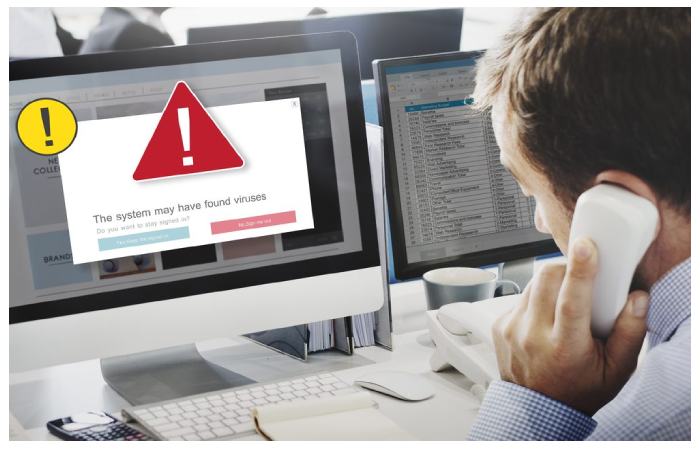Imagine this scenario. You are comfortable with your system for an important task, and suddenly his device is misbehaving, unresponsive, and slow. If you are wondering what: “Is my computer infected with a virus?” then you are right.
Table of Contents
What is a Computer Virus?
Almost everyone is familiar with the term “virus.” A computer virus is very similar to a biological virus. A biological virus is transmitted from one person to another and can multiply within the host’s body. Similarly, a computer virus can spread from one computer to another and multiply once it has entered a device.
A computer virus is malicious code that infects legitimate programs and files, attaches itself to them, and spreads from device to device. It can cause serious damage to the system, damaging data and applications. It can also change how the device works, slowing down the system and preventing the necessary Windows processes and applications from loading.
How Does A Virus Works?

First, the virus attaches itself to a legitimate application and spreads through different systems through various means, such as USB sticks. Having entered the system through an infected program, the virus will wait for the infected application to start. As soon as the computer user starts the infected application, the malicious codes within the application activate, and the virus begins to do its job. Shortly after the execution, the virus starts to multiply and adhere to system files and applications.
In addition to infecting the host device, the virus can damage all other devices connected to the same network. It can perform many illegal tasks such as stealing confidential data like passwords and bank details, corrupting important files, saving keystrokes, and more. Some destructive viruses can even permanently damage your device’s hard drive.
How Does A Computer Virus Spread?
To infect more and more devices, a computer virus needs the means to spread. These are the main ways that a computer virus spreads from one device to another:
- Traditionally, before the Internet, the floppy disk was the most common virus spread. Computer users unintentionally or intentionally copied infected applications onto floppy disks. When this drive was connected to other computers, the virus was also used to gain access. However, the virus is not activated until the infected program is started.
- Over time, the source of the virus has changed from floppy disks to other redistributable media like CDs, DVDs, USB sticks, etc.
- Today, viruses spread widely through Internet sites. Cybercriminals create bogus websites containing legitimate programs that have been infected with a virus to spread viruses—users who are unaware of the infection download applications as fair. Torrents are very popular with cybercriminals for spreading viruses.
- Email is another popular virus distribution tool for cybercriminals. Emails with catchy subject lines and images are sent with infected attachments for easy download by users.
- Viruses also spread through malicious JavaScript when users visit infected websites. Malicious JavaScript loads in the background and starts downloading the virus onto the system.
5 Signs that Indicates the Existence of Virus
When a harmful biological virus infects the human body, abnormal symptoms appear in the body, indicating an infection. Also, when a computer virus infects your system, it begins to misbehave and shows some signs that confirm the infection. Here are 5 main signs of a viral infection on a computer system.
1.The Computer Becomes Slow
The most common symptom of a virus attack is a slow computer. If your system suddenly becomes slow and applications take a long time to load, it could be because viruses are using most of your system’s RAM, making it difficult for other applications to run. You can start Task Manager to check which applications or processes are consuming system resources.
2.Internet Use Increases Abnormally
When a virus enters a system, the use of that system on the Internet can increase abnormally as viruses can use the network to spread. You can check which application or process is using the Internet in Task Manager.
3.Frequent Computer Failures.

Some deadly viruses can severely damage your device’s hard drive, causing frequent computer crashes. Users can regularly encounter a Blue Screen of Death (BSOD) error.
4.All Files Become Shortcuts
If, when transferring data from Pendrive or other external drives, you notice that all files and documents have become a shortcut, it may be due to a shortcut virus. This usually happens when users do not scan external drives with an antivirus program.
5.Unknown Application Icons Displayed On The Desktop.
After a virus attack, unknown application icons appeared on the desktop screen. These icons can represent malware. These programs usually install with the supplied software.
How To Stay Protected From Viruses?
Viruses can be dangerous and can disrupt your workflow, creating havoc on your system. To keep your system safe from viruses, it is important to follow preventive measures.
Here are some tips on how to protect your computer from viruses:
- Always stay up-to-date with the hottest developments in the cyber world and new virus infections through cybersecurity blogs like viruspup.com and others.
- Equip your system with a reliable anti-malware program like MalwareFox.
- When transferring files from external sources, remember to scan them thoroughly before proceeding.
- Never download attachments for emails sent by an unknown sender.
- Update your system and applications to the latest version.
- Never visit unsafe or untrustworthy sites while waiting for free software and games.
- Torrents are a popular virus distribution tool. Never visit torrent sites for illegal downloads.
